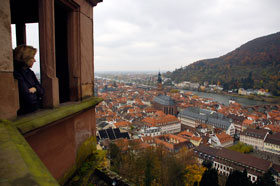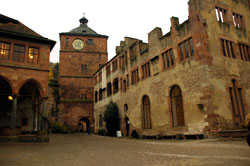 The gray sky couldn’t fully mute the reds, yellows, greens and oranges of fall that were sprinkled throughout the rolling hills surrounding Heidelberg today. The colors popped through a lacy mist draped over the valley. The fall hues weren’t the only colors stubborn enough to stand out from the gray haze. “Heidelberg is known for it’s colorful rooftop landscape,” said Charlotte. Charlotte was the tour guide for our official “introduction to Germany,” our introduction to the aged land. I couldn’t help but think the misty atmosphere set the perfect mood for our slow saunter through a historic German town marked by Baroque architecture and art.
The gray sky couldn’t fully mute the reds, yellows, greens and oranges of fall that were sprinkled throughout the rolling hills surrounding Heidelberg today. The colors popped through a lacy mist draped over the valley. The fall hues weren’t the only colors stubborn enough to stand out from the gray haze. “Heidelberg is known for it’s colorful rooftop landscape,” said Charlotte. Charlotte was the tour guide for our official “introduction to Germany,” our introduction to the aged land. I couldn’t help but think the misty atmosphere set the perfect mood for our slow saunter through a historic German town marked by Baroque architecture and art.
The tour of Heidelberg jump started the series of activities John Deere has scheduled for our group of ag journalists. We are here to learn about John Deere’s growing prominence in the European agriculture industry, Germany’s deep-rooted agricultural value and the latest innovations in farm machinery being showcased in Agritechnica 2007 – which kicks off next week.
I can’t speak for the rest of the group, but for me, getting acquainted with a notably historic city in Germany seemed like a most appropriate way start to exploring the country’s agricultural identity. One of Heidelberg’s biggest draws is it’s authenticity. Heidelberg is one of the few cities that was left unscathed by the bombings of World War II. This doesn’t mean the city didn’t face it’s share of devastation and destruction from enormous blasts of gunpowder during the Thirty Years War, and by the French in 1689 and 1693. It also suffered a stone-crumbling strike of lightening in 1764. But, it does mean that many buildings that enclose the city’s quaint market squares and the famed castle ruins that sit 300 feet above are true remnants of historic Germany and are not some mere recreations.
 The remains of Schloss Heidelberg Castle are the most dominant features of the Heidelberg landscape, resting above the River Neckar. They once housed the Palatine princes during the Holy Roman Empire of the 15th century. The castle’s Elizabeth gate is a warm symbol of romance for Germans, as the gate was a gift from a young 19-year-old prince to his young 19-year-old wife. The most notable artifacts inside the castle are the enormous wine barrels, including the world’s largest wine barrel which can hold about 55,000 gallons of wine. Today, the barrel remains empty. Heidelberg’s old bridge which spans the River Neckar is one of Germany’s most famed bridges. Heidelberg is also home to Germany’s oldest University, which was founded in 1386. The charm of this old German city also caught the poignant attention of Mark Twain, who delighted over its splendor in his book A Tramp Abroad.
The remains of Schloss Heidelberg Castle are the most dominant features of the Heidelberg landscape, resting above the River Neckar. They once housed the Palatine princes during the Holy Roman Empire of the 15th century. The castle’s Elizabeth gate is a warm symbol of romance for Germans, as the gate was a gift from a young 19-year-old prince to his young 19-year-old wife. The most notable artifacts inside the castle are the enormous wine barrels, including the world’s largest wine barrel which can hold about 55,000 gallons of wine. Today, the barrel remains empty. Heidelberg’s old bridge which spans the River Neckar is one of Germany’s most famed bridges. Heidelberg is also home to Germany’s oldest University, which was founded in 1386. The charm of this old German city also caught the poignant attention of Mark Twain, who delighted over its splendor in his book A Tramp Abroad.
Our tour guide Charlotte seemed just as enthralled with the city as Mark Twain. She spoke of the city, the castle and the intimate realities and secrets of the Palatine rulers with enthusiasm, speaking of them with a fondness almost befitting that of a beloved relative. Charlotte brought the figures of Heidelberg’s history to life and her recount of events lured you into the storied drama of Heidelberg.
